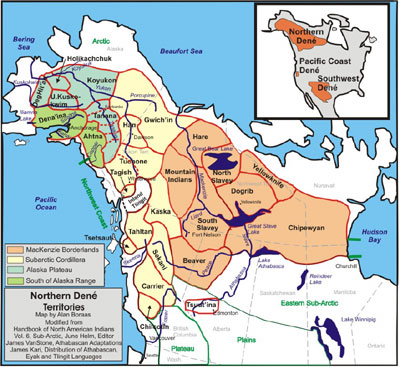Language Relationships
Dena’ina is a member of the Dene (or “Athabascan”) family of languages. While we sometime speak of Dene as if it were a language itself, it more properly refers to a family, or group of related languages.

Northern Dené Territories map (courtesy Alan Boraas)
Language Change
One of the facts of human language is that language changes over time. Grandchildren don’t speak exactly the same way as their grandparents, and over time these small changes can lead to large differences in ways of speaking–large enough for two different forms of speech to be considered different languages. The fact of language change is clear to English speakers upon hearing the language of Shakespeare or even upon trying to read books written a hundred years ago.
The Dena’ina language as spoken today is the result of language change over many centuries. Dena’ina is one of nearly forty languages which are descendend from a common ancestral language. These languages together comprise the Dene family of languages. These languages are related in the same sense that brothers and sisters are related in a biological family: they share a common parent.
Distribution
Dena’ina is one of eleven Dene languages spoken across Interior Alaska and the Cook Inlet region. It is the only Dene language in Alaska which occupies a coastal environment. Still more Dene languages are spoken across Western Canada, the Pacific Northwest, and the desert Southwest of the United States.
It is possible to recognize three major geographic groups of Athabascan languages: Northern, Pacific Coast, and Southwest. Within the Northern group there are four subgroups: Southern Alaska, Alaska Plateau, Subarctic Cordillera, MacKenzie Borderlands. These are indicated on the map above. The names of Alaska Athabascan languages and the regions in
| Gwich’in | Porcupine River, Yukon River, Old Crow |
| Han | Yukon River |
| Koyukon | Yukon-Koyukuk Rivers |
| Deg Xinag | Lower Yukon |
| Holikachuk | Innoko River |
| Upper Kuskokwim | Kuskokwim River |
| Tanana | Lower Tanana River |
| Tanacross | Middle Tanana River |
| Upper Tanana | Upper Tanana Basin |
| Ahtna | Copper River |
| Dena’ina | Cook Inlet, Susitna River, Nondalton |
Language Similarities
Athabascan languages are closely related to each other. Speakers of different Athabascan languages often find that they are able to communicate in a basic way with some difficulty, even if they have no previous experience with each other’s languages. Some words are very similar across many language in the family. For example, the Dena’ina word for ‘grass’, tl’egh is almost the same as that in Navajo (tl’ox), even though more than 3000 miles intervenes between Dena’ina and Navajo territories.
In some cases comparing languages reveals cultural differences. For example, the word for ‘dog’ in Northern Athabascan languages is something like łii (łik’a in Dena’ina). This word is closely related to the Navajo word łii; however, in Navajo this word refers to ‘horse’, not ‘dog’, reflecting the cultural importance of horses in Navajo but not in Dena’ina.
Dena’ina is unique among the Athabascan language in having innovated many new terms for common things. For example, the word minłni ‘water’ is found only in Dena’ina. No other Athabascan language has a word for water (or for anything else) which is related to this word. The usual word for water in other Athabascan is something like tu.
Compiled by Gary Holton 15 Oct 2005.